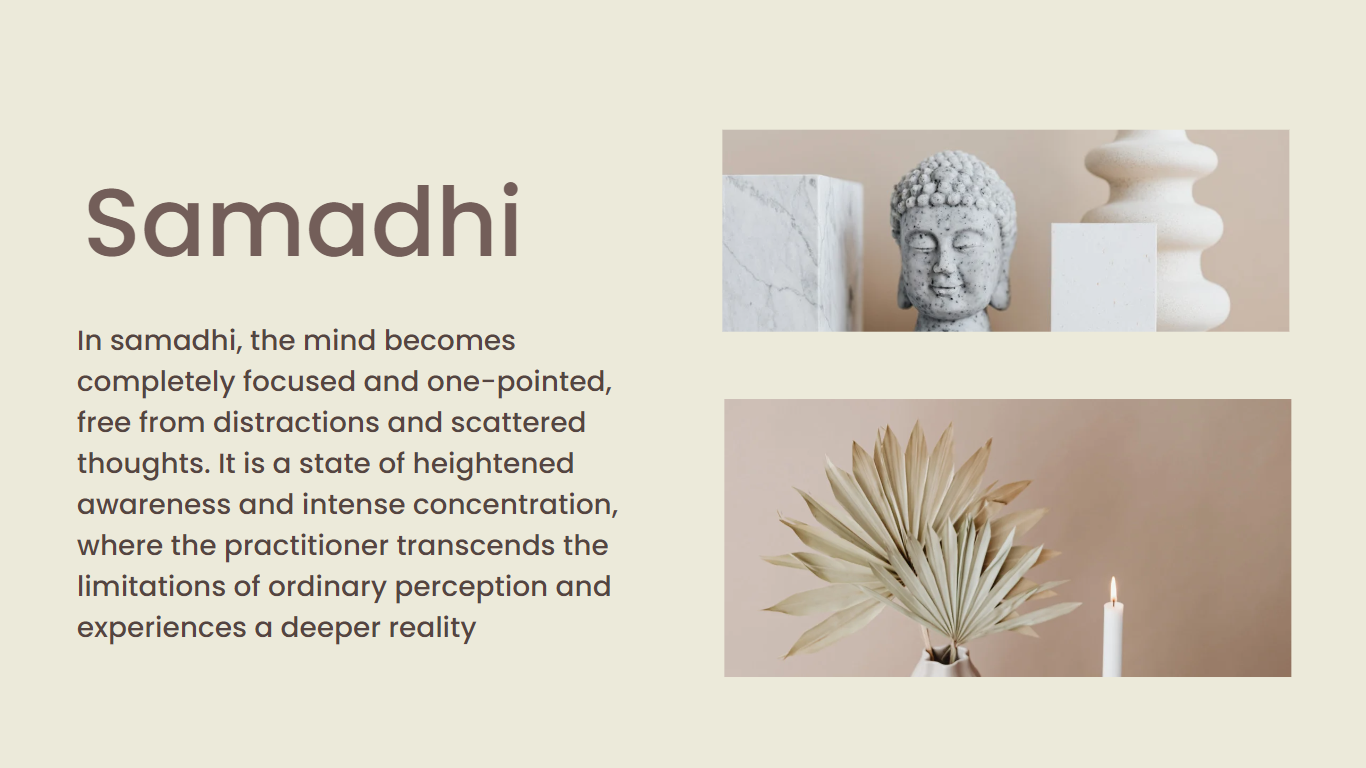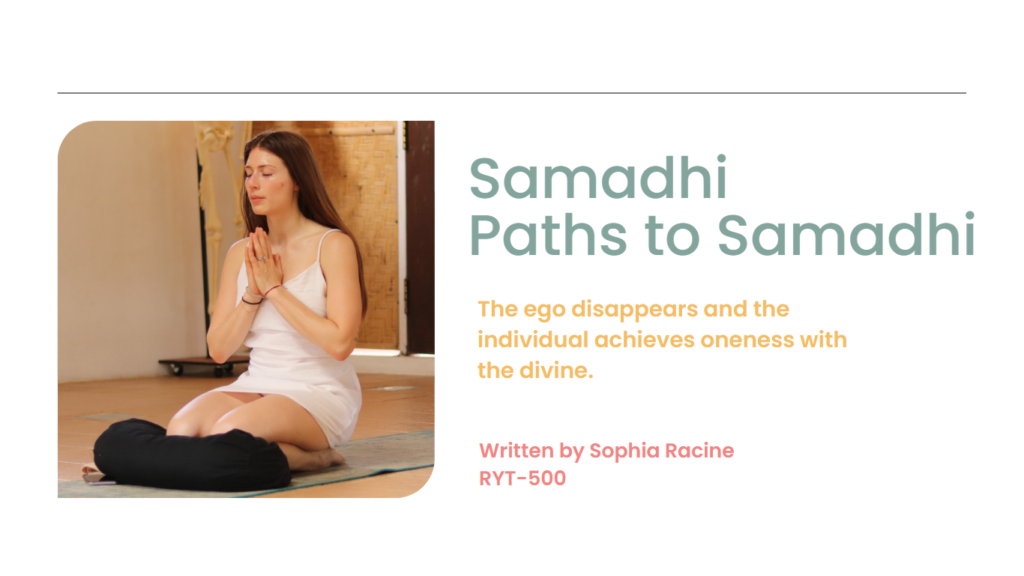Let’s discuss the significance of Samadhi for the practice of Yoga. What insights do scriptures offer about this term, and how can we integrate Yogic principles into our pursuit of enlightenment? Put simply, how do we attain moksha? What steps can we take to free our senses from the distractions of the material world? These questions will be explored, beginning with an exploration of the definition of Samadhi and its various interpretations across different yogic scriptures.
For students who study Samadhi, Dhyana, and Yogic philosophy during formal Yoga Teacher Training, this concept forms a core part of the journey toward self-realization. Understanding Samadhi is especially essential for anyone considering a deeper path such as the Yoga Teacher Training School program or our structured Yoga Teacher Training Europe curriculum.
Definition of Samadhi
Samadhi is defined as the ultimate stage of Yoga practice, marking the realization of union with the supreme power. It is attained through deep meditative concentration.
State of Profound Meditation
In essence, Samadhi is a state wherein one experiences complete absorption in the absolute. Here, the mind remains undisturbed by sensory input, desires, anger, or ego-generated thoughts.
Experience of Oneness
During Samadhi, the ego dissolves, and the individual achieves a sense of oneness with the divine. It is considered the pinnacle of meditation, where the ceaseless wheel of thoughts comes to a standstill, and the mind merges with the universal consciousness.

In the Hatha Yoga Pradipika, Swami Svatmarama discusses Samadhi in the context of “Nada” yoga, which focuses on the inner sound or vibration heard during meditation. He explains that the sound “Nada” represents the cosmic vibration that leads to higher consciousness. Swami Svatmarama suggests that yoga practitioners should experience the four states of Nada to attain higher states of consciousness, resulting in inner peace and bliss, ultimately leading to liberation or the state of Samadhi.
Furthermore, the text highlights the topic of Kundalini and establishes a connection between Kundalini and Samadhi. It is believed that once the Kundalini energy within us awakens, the state of higher consciousness is finally achieved. Swami Svatmarama discusses various methods to awaken our primal energy, Kundalini, which resides at the base of our spine. The remedies listed include innate Kundalini, mantra, penance, herbal awakening, Raja Yoga sadhana, pranayama, kriya, tantrik diksha, shaktipat, and ultimately surrender.
Stages of Samadhi
Moreover, Swami Svatmarama discusses the several stages of Samadhi, each involving different levels of concentration and absorption. The first stage is called dharana, which refers to the ability to focus the mind on a specific object or point. The second stage is dhyana, where the mind becomes completely absorbed in meditation. The third and final stage is known as samadhi proper, where the individual is fully immersed in oneness during the meditation.
Types of Samadhi
Swami Svatmarama also explains the two types of Samadhi. The first is savikalpa, where no further mental activity is required, and one simply maintains focus. The second is nirvikalpa, where there is no longer any focus, and the practitioner becomes one with the state of meditation or consciousness.
The Hatha Yoga Pradipika further elucidates that within the state of full consciousness, where the ego dissipates, the self merges with the divine.
Additional Stages of Samadhi | Hatha Yoga Pradipika
There are four additional stages: Arambha, where one hears a tinkling sound vibrating throughout the body; Ghata, resembling the sound of a kettle; Parichaya, characterized by the sound of drums; and Nishpatti, which is achieved through the Nada discussed earlier. In Nishpatti, all sounds merge with the mind, and the yogi remains unaffected and unattached to any sensory experiences. At this moment, the yogi is completely liberated from all and impervious to harm.
Understanding Samadhi in the Gheranda Samhita
Let’s explore the concept of Samadhi as outlined in the Gheranda Samhita.
Eight Limbs of Yoga
The Gheranda Samhita emphasizes the path of Yoga through the practice of Ashtanga Yoga, the eight limbs outlined in Patanjali’s Yoga Sutras:
Yama: Social and ethical guidelines.
Niyama: Internal observances and personal disciplines.
Asana: Physical postures to cultivate stability and ease.
Pranayama: Breathing techniques to regulate energy.
Pratyahara: Withdrawal of the senses from external distractions.
Dharana: Concentration to focus the mind.
Dhyana: Meditation and letting go of mental chatter.
Samadhi: Attainment of pure bliss and union with the divine.
Seven Additional Limbs
In addition to the eight limbs, Gheranda Samhita introduces seven supplementary practices to achieve complete enlightenment Sage Gheranda summarizes them as Saptanga Yoga starting with
Shatkarma: Cleansing practices to purify the body and remove toxins.
Asana: 32 postures to strengthen the body.
Mudra: Gestures used to regulate the flow of prana (life force) in the body.
Pratyahara: Withdrawal of the senses from external distractions.
Pranayama: Different techniques to regulate the breath.
Dhyana: Meditation or the practice of maintaining awareness of the self.
Samadhi: The state of complete absorption in the Divine.
Comprehensive Approach to Samadhi
By combining the eight limbs of Yoga with the supplementary practices of Shatkarma and Mudra, the Gheranda Samhita provides a holistic framework to attain the state of Samadhi.
Six different types of Samadhi by Sage Gheranda
It is important to mention that Sage Gheranda discusses the six different types of Samadhi that enable individuals to attain oneness with the supreme.
These types are as follows:
Dhyana Samadhi: By bringing the eyes to the third eye in a meditative state.
Nada Samadhi: Focusing on the inner sound, often compared to the buzzing of a bee.
Rasananda Samadhi: Experiencing the blissful taste through the practice of the Khechari mudra.
Laya Samadhi: Absorption in oneself as the divine, realizing the higher self, often associated with Lord Brahma.
Bhakti Yoga Samadhi: Engaging in contemplation of one’s chosen deity as a form of devotion.
Raja Yoga Samadhi: Meditating with breath control and retention, known as kumbhaka.
These different types of Samadhi provide practitioners with various approaches to attaining the state of oneness with the supreme.
Top 3 essential secrets of life | the Bhagavad Gita
Samadhi is also emphasized as the state of complete absorption in the divine, and as the ultimate liberation, known as Moksha. The Bhagavad Gita imparts fundamental teachings on how to attain enlightenment by emphasizing three essential secrets of life.
The first secret is Karma Yoga, the path of selfless action.
The second secret is Bhakti Yoga, the path of devotion and love for the divine.
The third secret is Jnana Yoga, the path of knowledge and seeking the truth to understand one’s true nature.
These three paths lead individuals toward the ultimate goal of reaching the state of Samadhi. These teachings are deeply explored in traditional YTT programs such as the 200 Hour Yoga Teacher Training, where philosophy, meditation, and the science of consciousness become an important foundation for future teachers.
Concept of Samadhi | The Yoga Sutras of Patanjali
Patanjali describes Samadhi as the culmination of the yogic path, where the practitioner achieves a profound state of absorption, union, and oneness with the object of meditation or with the divine.
The different stages of Samadhi described by Patanjali in the Yoga sutras are:
Savitarka Samadhi
In this initial stage of Samadhi, the practitioner experiences absorption accompanied by reasoning. The mind is still engaged in cognitive processes, but it is fully focused on the chosen object of meditation, such as a mantra, an image, or the breath.
Nirvitarka Samadhi
This stage involves a deeper level of absorption where the cognitive processes cease, and the practitioner experiences a state of pure awareness without distracting thought. The mind becomes completely absorbed in the object of meditation, leading to a profound sense of inner peace and clarity.
Savichara Samadhi
This stage of samadhi is characterized by subtle analysis or reflection. Although the gross aspects of discursive thought have ceased, there is still a subtle form of mental activity involved in discerning the nature of reality or the object of meditation.
Nirvichara Samadhi
In this deeper form of absorption even the subtle analysis or reflection ceases, and the practitioner experiences a state of pure awareness beyond all mental activity. The mind becomes completely still, and the practitioner merges with the object of meditation in a state of unity and bliss.
Sasmita Samadhi
In this stage of Samadhi, a sense of “I-am-ness” still remains. While the practitioner has transcended ordinary egoic identity, there is still a subtle sense of self-awareness present.
Asamprajnata Samadhi
Also known as “nirbija” or seedless Samadhi is the highest and most profound stage of absorption described in the Yoga Sutras. In this state, the practitioner experiences complete transcendence of individual identity and merges with the universal consciousness. There is no sense of subject-object duality; only pure awareness remains.
The Yoga Sutras of Patanjali also suggest meditating on our dreams to plant seeds in our minds and reduce fluctuations during nighttime. The text further mentions yathabimat dhyana, a tailored meditation practice for individuals to help them achieve Samadhi.

Throughout the yogic scriptures, Samadhi is presented as the ultimate state of realization and is considered the pinnacle of yogic philosophy. It serves as the ultimate goal that the various aspects of yoga, including asana practice, prepare us for. It is essential to recognize that yoga is not solely confined to the physical aspect but encompasses a holistic approach, with Samadhi being a crucial element in attaining liberation. By delving into the meanings and explanations of Samadhi in different texts such as the Hatha Yoga Pradipika, Gheranda Samhita, Bhagavad Gita, and Yoga Sutras of Patanjali, we gain a deeper understanding of its significance and the practices and techniques that can lead us towards this state of oneness with the divine. Samadhi represents the ultimate realization and transcendence of the mind, allowing us to overcome obstacles, still the fluctuations of the chitta, and ultimately experience pure bliss and liberation.
For those who feel called to study these ancient teachings more deeply, our YTT Course and Yoga Teacher Training School programs offer a structured path to explore the philosophy and practice behind Samadhi. By embracing the path of yoga, with Samadhi as the ultimate destination, we embark on a transformative journey of self-discovery and spiritual growth.
If you want to delve deeper into the ancient wisdom and practices that culminate in this state of blissful union, we invite you to join our 200 h Yoga teacher training in Bali or our 200 hour Yoga course in Germany.
In the serene landscapes of Bali or the calm setting in the North of the Eifel National Park in Germany, our immersive Yoga training provides the ideal environment to deepen your understanding of yoga and experience its transformative power. Led by experienced and certified yoga instructors, our best Yoga teacher training programs encompass a holistic curriculum, encompassing asanas (postures), pranayama (breathing techniques), meditation, philosophy, anatomy, and teaching methodology.
Popular Courses in Bali
200 hour Yoga Teacher Training in Bali | 300 hour Yoga Teacher Training in Bali | 500 hour Yoga Teacher Training in Bali | 50 Hours Yin Yoga Training in Bali | 50 hours Pranayama Training in Bali | 50 hours Yoga Nidra Training Bali | 50 hours Arm Balancing Training Bali | 100 hour Ashtanga Training Bali
Popular Courses in Germany
200 hour Yoga Teacher Training in Germany | 300 hour Yoga Teacher Training Germany | 50 Hour Yin Yoga Training Germany | 50 Hour Pranayama Training Germany | 50 hour Yoga Nidra Training Germany | 50 Hour Arm Balancing Training | 100 hour Ashtanga Training Germany

